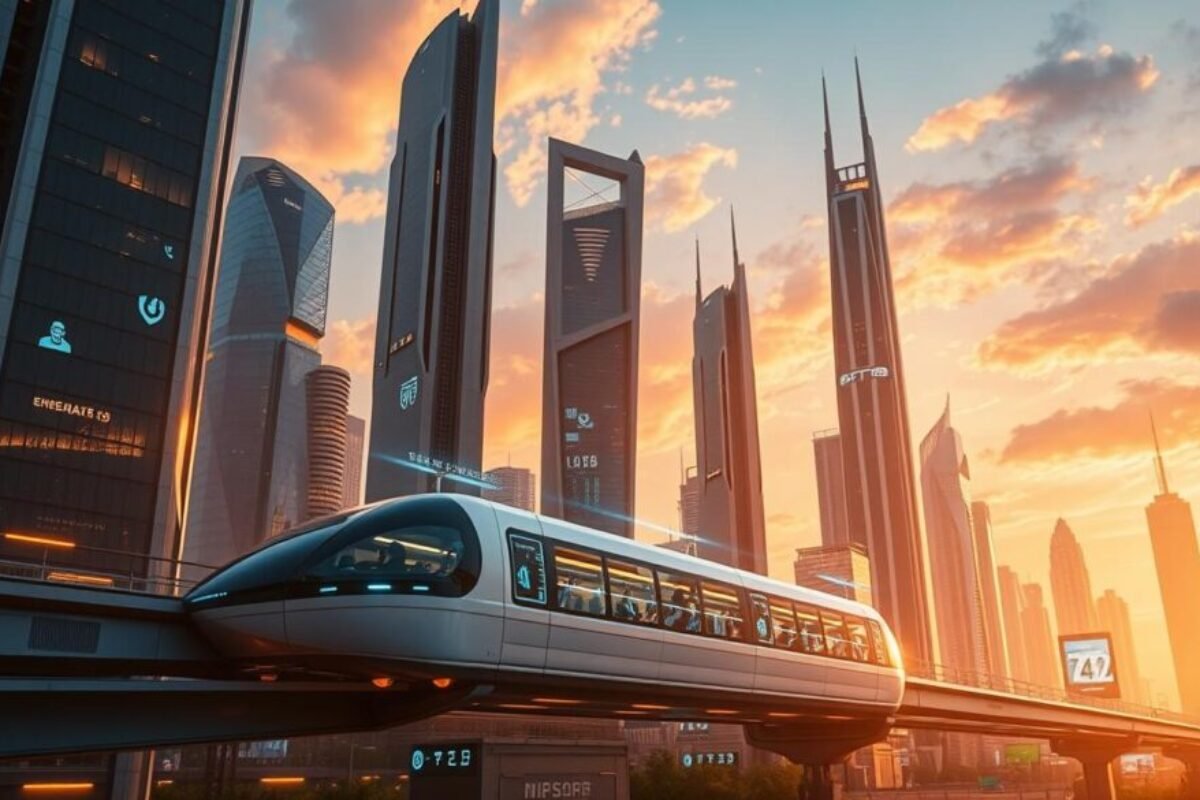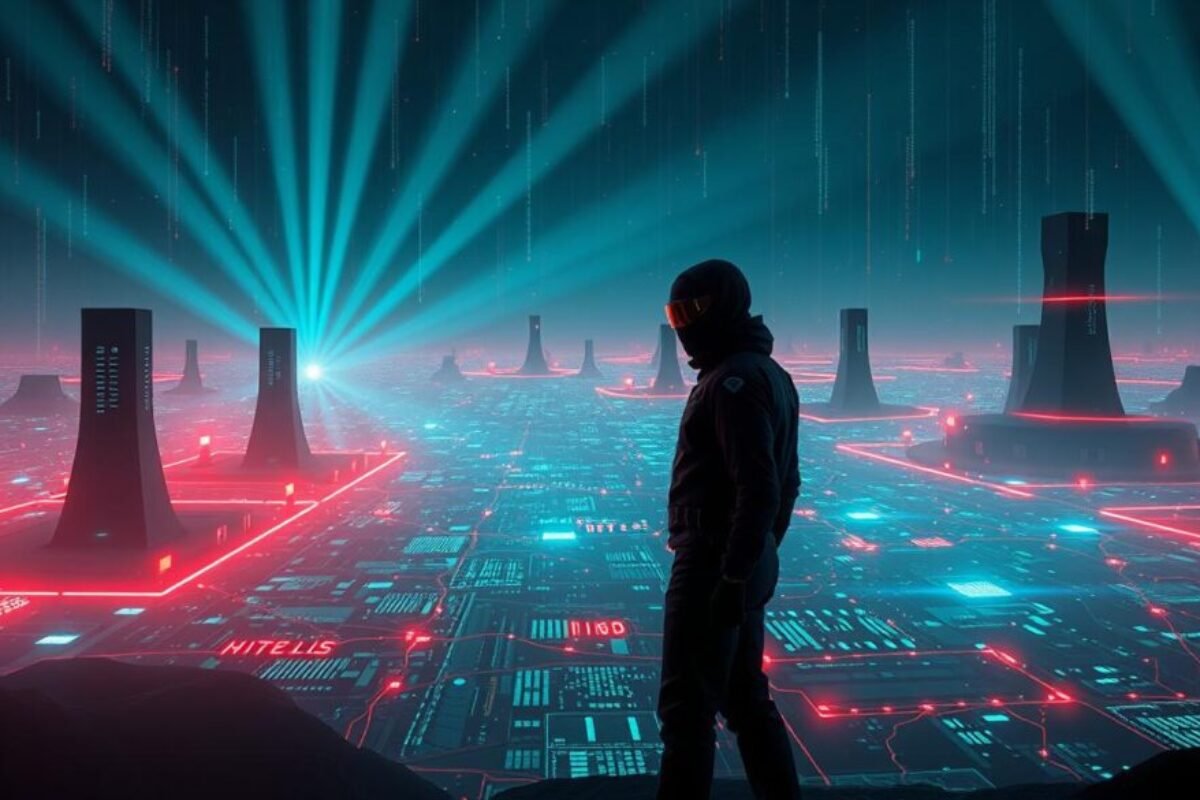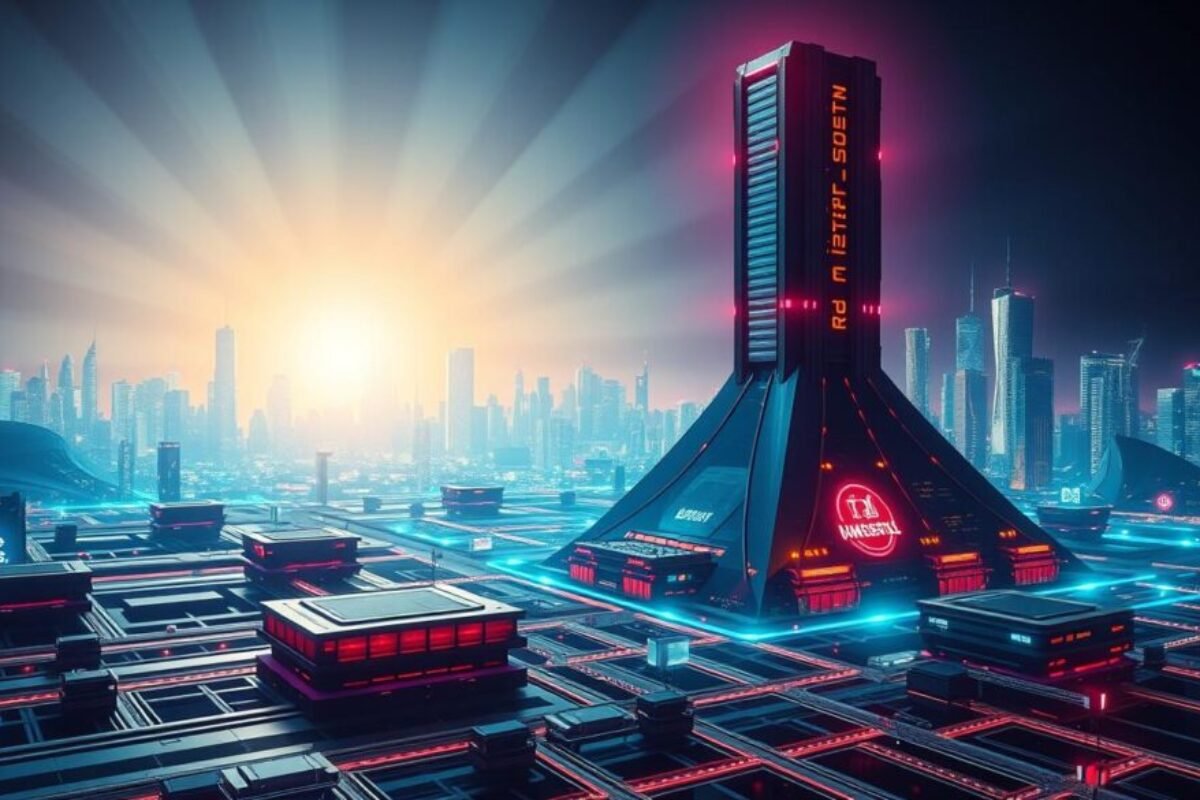Technology and the Future: Trends, Innovations, and Possibilities
Today, we live in a world where technology changes fast. It’s important to see how it affects our lives. New tech trends are changing how we work and live every day.
This article will explore the latest tech innovations. We’ll talk about what the future holds for innovation. We’ll also look at how it will impact us all, both personally and professionally. We’ll use data from Gartner to show why IT pros need to keep up with these changes.
Key Takeaways
- Technology and the future are intricately linked, driving evolution in various sectors.
- Staying abreast of emerging trends in technology is essential for success.
- Innovation will continue to change how we interact with our world.
- Understanding strategic technology trends is vital for IT professionals.
- Adaptability is key to thriving in a fast-paced technological landscape.
Introduction to Emerging Technology Trends
In today’s fast-changing world, we see many emerging trends in technology that change our lives and work. It’s important to understand these trends because they often lead to big technological advancements. We’re looking into key areas of tech innovation trends to see which technologies are becoming popular and what they might mean for us.
The innovation cycle shows us how new technologies go from idea to being widely used. We see fast growth in areas like artificial intelligence, blockchain, and cybersecurity. This shows how society’s needs are changing.
Reports, like Deloitte’s Tech Trends report, show AI’s big impact on many technological advancements. This wide influence means that companies that get and use these new tech trends will do well. They will help create a world where innovation leads to progress.
As we move through this changing world, it’s key to notice these changes. Knowing about these shifts helps us use new technologies to our advantage. This way, industries and people can keep up with the fast-changing tech world.
The Role of AI in Shaping the Future
Artificial Intelligence (AI) has grown from a buzzword to a key player in tech advancements. It’s changing healthcare, finance, logistics, and more. AI and future tech work together, making things more efficient and helping us make better decisions.
In healthcare, AI uses predictive analytics to improve patient care. For example, it can look through big data to spot health issues early. This not only makes treatments better but also saves money, showing AI’s big impact on business.
Financial services are also using AI to better serve customers. AI systems give personalized advice based on how people act, making customers happier. AI’s ability to learn and change quickly is key in shaping the financial world.
Logistics is also seeing big changes thanks to AI. AI helps manage supply chains by making smart decisions on its own. This means products get to customers faster and cheaper. By using these advanced tools, companies can set new standards for how things get done.
Looking closer at AI’s abilities, we see it’s set to change industries even more. The mix of AI and future tech is leading to huge leaps forward. Our look into these advancements shows us all the possibilities that are within our reach.
Cutting-Edge Tech Developments in 2025
Looking ahead to 2025, we see big changes in tech. Generative AI is leading the way, changing how we make and use content. It’s great for businesses wanting to stay ahead.
Quantum computing is also a big deal. It’s going to make data processing and solving problems much faster. Companies like IBM and Google are working hard on this. It will help a lot of fields, like healthcare and finance.
5G technology is growing too. It will make everything faster and more connected. This will help make cities smarter and improve things like telemedicine and self-driving cars.
| Technology | Potential Applications | Industry Impact |
|---|---|---|
| Generative AI | Content creation, personalized marketing | Enhanced creativity and efficiency in media and advertising |
| Quantum Computing | Complex simulations, cryptography | Revolutionized data security and analytics capabilities |
| 5G Technology | Real-time data sharing, smart cities | Improved urban planning and emergency response systems |
By 2025, these tech advancements will change our lives and work. Embracing this future will open up endless possibilities for innovation. It will drive progress in many areas.
Generative AI: Revolutionizing Content Creation
Generative AI is changing the game in content creation. It’s making waves in many fields. Marketing, design, and entertainment are all seeing big changes. This technology lets businesses reach more people and connect with them in new ways.
The Impact of Generative Models on Industries
Generative AI is boosting creativity in many areas. In publishing, tools like OpenAI’s ChatGPT and Jasper help writers work faster. Game designers at Ubisoft use it to make games more exciting. Ad agencies use it to make ads that speak directly to their audience.
Application of Generative AI in Business
Companies are finding many ways to use generative AI. Adobe uses its Sensei platform to make design easier. It helps designers create amazing visuals quickly. AI also helps in customer service, making it easier to keep customers happy.
| Industry | Generative AI Application | Example |
|---|---|---|
| Publishing | Content generation | OpenAI’s ChatGPT for blog posts |
| Design | Graphic creation | Adobe Sensei for visual design |
| Game Design | Dynamic content generation | Ubisoft’s implementation |
| Advertising | Personalized campaigns | AI-driven targeted messaging |
| Customer Service | Automated responses | AI chatbots in various businesses |
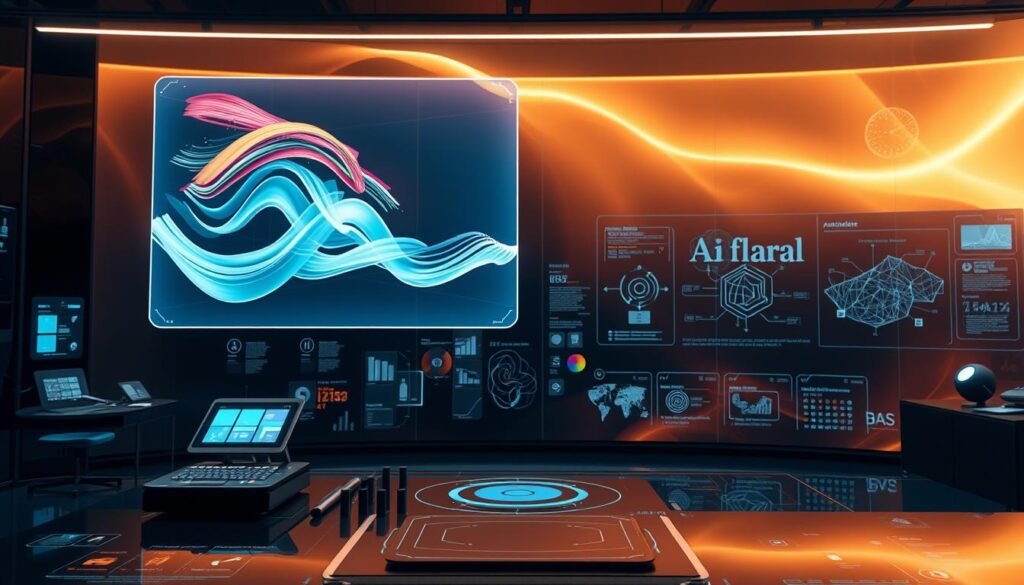
Quantum Computing: The Next Leap Forward
Quantum computing is changing the tech world. It’s different from old computers because it uses quantum bits, or qubits. This lets quantum computers do complex tasks much faster than regular computers.
Quantum computing has many uses. It can make our online data safer with new encryption. But it also makes old encryption methods less secure. This means we need to update how we protect our data.
The drug discovery process could also get a big boost. Quantum computers can simulate how molecules work. This could lead to finding new medicines faster.
Quantum computers are great at solving big problems. They can help make supply chains more efficient and predict financial markets better. We’re seeing big steps forward in this field.
Looking ahead, quantum computing is more than just a dream. Companies like IBM, Google, and Rigetti Computing are working hard on it. They see its power to change industries and the economy.
5G Expansion: Enabling New Technologies
The growth of 5G technology is a big step forward in the digital world. It sparks new ideas in many fields. This includes the Internet of Things (IoT), self-driving cars, and virtual reality, where fast data and quick responses open up new possibilities.
5G lets devices talk to each other in real-time. This makes things work together smoothly. It also makes things like self-driving cars possible by allowing them to react fast.
Studies show 5G is much faster than 4G, up to 100 times. This isn’t just about speed. It also means better and more reliable services for users.
With 5G, we’re seeing new technologies emerge. It’s changing how we see and interact with the world. Industries are finding new ways to use this powerful network.

Virtual Reality and Its Future Applications
Virtual reality is changing fast, making our digital world more engaging. It’s used in gaming, training, and therapy, showing its huge promise. Companies like Oculus, HTC, and Sony are at the forefront, making better gear for everyone.
In gaming, VR takes us into amazing worlds. Games like Beat Sabre and Half-Life: Alyx show how VR can tell stories and create fun spaces. As tech gets better, we’ll see more games that use VR’s special features.
VR is also changing education and training. It’s used in healthcare and aviation for learning. For example, medical students practice surgeries in a safe, realistic setting. This boosts their skills and confidence without risk.
VR is also helping with mental health, like anxiety and PTSD. It’s used in therapy to help people face their fears slowly. This method has been shown to be very effective, making VR a key tool in therapy.
Looking ahead, VR will be everywhere, in many fields. Better tech will make it even more popular. This will open up new ways for VR to improve our lives in ways we can’t imagine yet.
Augmented Reality: Bridging the Physical and Digital Worlds
Augmented reality changes how we see the world. It mixes digital stuff with our real surroundings. This mix-up is used in many areas, like shopping, learning, and training.
In retail, AR makes shopping better. People can see how products fit in their homes before buying. They use phones or AR glasses to check out furniture or paint colours. This makes shopping more fun and helps sell more.
Education also gets a big boost from AR. It turns boring lessons into exciting adventures. Students can explore 3D models and simulations of complex topics. This way, they learn more and remember it better.
Training in many fields uses AR too. It lets people practice in safe, real-like settings. For example, doctors can practice surgery without risking real patients.
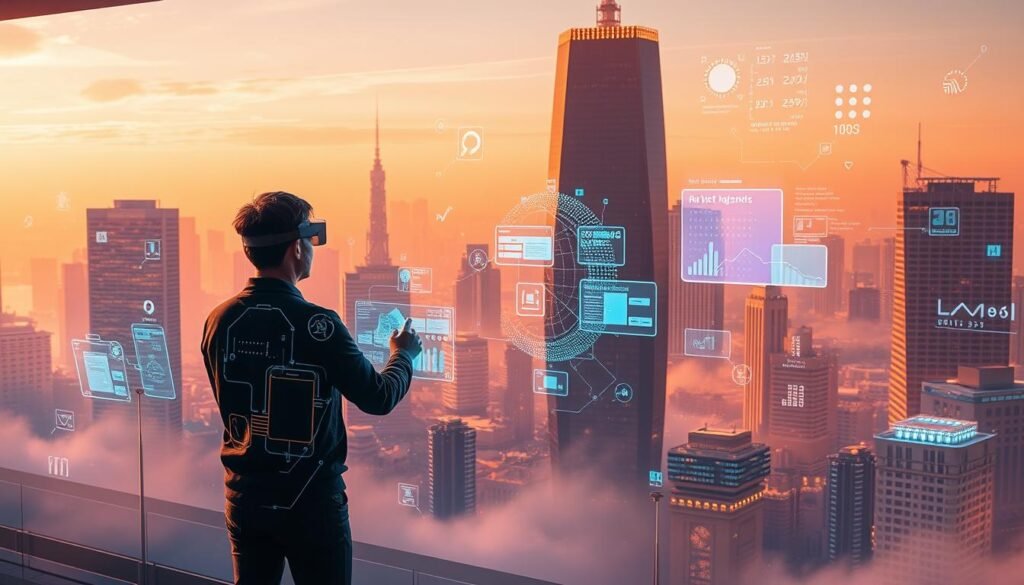
Looking into AR’s latest, we see its huge impact on many areas. It’s changing how we live and work. Using AR brings new ideas and makes things more efficient in many fields.
Internet of Things: Transforming Smart Cities
The Internet of Things (IoT) is changing urban life. It connects many devices, making cities smarter and more efficient. This technology helps cities manage resources better, improving life for everyone.
IoT is key in managing energy. It lets cities track energy use and adjust to needs in real time. Smart meters help cut down waste and save money, making cities greener.
Public safety also gets a boost from IoT. Sensors monitor traffic and the environment, helping emergency teams. For example, cameras and sensors help police respond quickly to crime or accidents.
As cities use more IoT, they need new rules to keep up. Laws must cover data privacy, security, and how different systems work together. A good smart city needs technology and rules that help everyone live safely and efficiently.
Biotechnology in Agriculture: Innovations for Sustainability
Biotechnology is key in making farming more sustainable. We face big challenges like climate change and less land for farming. New methods, like CRISPR gene editing, help farmers grow stronger crops.
CRISPR lets farmers tweak specific genes in crops. This makes crops better at fighting pests and diseases. It also helps them handle extreme weather.
These new tools are very important. They help us grow more food and protect the environment. Old farming ways use lots of chemicals that can hurt nature. Biotechnology helps by using fewer harmful chemicals and growing more food.
But, we must think about the ethics of using these technologies. We need to use them wisely. This way, we can enjoy their benefits while keeping the environment safe.
| Biotechnology Tools | Advantages | Impact on Sustainable Agriculture |
|---|---|---|
| CRISPR | Precision editing of genes | More resilient crops |
| Gene Mapping | Identifying beneficial genes | Improved crop variety selection |
| Microbial Solutions | Enhanced soil health | Reduced dependence on chemical fertilizers |
| Biopesticides | Targeted pest management | Lower environmental toxicity |
Autonomous Vehicles: The Future of Transportation
Autonomous vehicles are changing how we travel. They make our journeys safer, more efficient, and accessible. Thanks to AI, machine learning, and sensors, these cars can handle complex routes better than humans.
Many car makers are adding self-driving tech to their cars. Tesla, Waymo, and Ford are leading this change. In 2023, we saw more tests and programs to improve the tech and calm public fears.
But there are hurdles to overcome. Laws need to catch up with the tech, making it hard to figure out who’s liable. As more self-driving cars hit the road, governments must create clear rules for safety and innovation.
Our cities will also change with more self-driving cars. We might see fewer cars owned by people. This could make cities better for walking and biking, reducing traffic and pollution.
| Aspect | Benefits | Challenges | Future Implications |
|---|---|---|---|
| Safety | Fewer accidents from human mistakes | Public worries about reliability | More trust as tech gets better |
| Efficiency | Less traffic and better flow | Need for better roads | Smart roads for cars |
| Accessibility | More mobility for all | Rules to follow | Transport for everyone |
| Environmental Impact | Less pollution | Dependence on energy | Green transport |
As we move towards a future with self-driving cars, our travel will change a lot. By solving problems and using the tech’s benefits, we’re heading towards safer, better travel.
Blockchain Technology: Beyond Cryptocurrencies
Blockchain technology has grown a lot from its start in the world of cryptocurrencies. Now, it’s used in many new ways. Companies in different fields are using it to make things more efficient and secure.
In supply chain management, blockchain shines. It helps track products from start to store. This makes sure products are real and cuts down on fraud. It builds trust with customers and partners.
Blockchain is also changing voting systems. It makes voting safer from tampering and fraud. This boosts voter confidence and makes elections more reliable.
The healthcare field is also seeing the benefits of blockchain. It helps manage patient records and keep medical data safe. It creates a single place for patient info, making things easier and safer.

As we see, blockchain’s uses go far beyond just cryptocurrencies. It’s set to play a big role in making things better in many industries.
The Future of Innovation: Edge Computing
Edge computing is changing how we handle data. It moves processing and storage closer to where data is created. This makes things faster and more efficient. It’s key as we use more IoT devices, helping many areas grow.
Edge computing is vital in smart cities and healthcare. For example, self-driving cars need quick data analysis to move safely. Without edge computing, they might not work well.
- Healthcare: It lets doctors make quick decisions.
- Manufacturing: It makes machines work better.
- Logistics: It tracks shipments easily, improving delivery.
Edge computing offers many benefits:
| Advantage | Description |
|---|---|
| Reduced Latency | It makes data processing quicker, leading to faster actions. |
| Enhanced Security | It keeps data safer by keeping it closer to its source. |
| Scalability | It fits well with current systems, making it easy to grow. |
As technology keeps advancing, edge computing is key. It helps us build a future that’s efficient and ready for change.
AI and Future Technology: A Paradigm Shift
The world of industries is changing fast, thanks to AI and future tech. These new tools are making a big difference. They help businesses use machine learning and data analytics in new ways.
AI is making business decisions better. It uses predictive analytics to guess what the market and customers will do. This helps companies make smarter choices.
Personalization is key in customer service now. With AI, businesses can offer what customers want. This makes customers feel more connected to the company.
This move to AI is real and affects businesses in big ways. Companies that use AI well get ahead of their competitors. Every field, from healthcare to finance, sees how AI improves things and makes work more efficient.
Robotics and Future Possibilities: Automating Industries
In recent years, robotics technology has changed many sectors, like manufacturing and healthcare. Robots make these industries better by boosting productivity, safety, and precision. This change is key to modern automation in industries.
In manufacturing, robots do tasks like assembly and quality checks. They do these jobs with high accuracy, making products better. Robots also cut down on workplace injuries, showing how automation in industries can be a game-changer.
The healthcare field is also seeing big benefits from robotics. Surgical robots help doctors work more precisely, leading to quicker recoveries and better health outcomes. Rehabilitation robots help patients move again, showing how robotics can improve care quality.
But we must think about the ethics of more automation. As robots do more human jobs, the workforce might change a lot. We need to talk about job loss and the future of work as we move forward with robotics.
The journey of robotics technology is just starting. Its role in automation in industries brings both opportunities and challenges. We must be ready to adapt and address these issues as we go.
Technology and the Future: The Role of Digital Twins
Digital twins are a new idea in technology and the future. They let companies create virtual versions of real things. These digital copies use real-time data to improve operations in fields like making things and building cities.
Digital twins can make things work better and help come up with new ideas. They act like real things, giving important insights. This helps industries work better and less often stop.
They also help in planning cities. City planners use them to look at traffic, energy use, and how resources are used. This helps make cities smarter and stronger.
Digital twins are key in the changing world of technology and the future. They make things work better and help industries always get better. They are all about making things better and faster.
Conclusion
Looking back at our journey through the future of technology, we see big changes ahead. New trends are not just changing industries but our everyday lives too. Advances in AI, blockchain, biotechnology, and robotics are weaving a new world of efficiency, connection, and green living.
We need to stay alert and ready for these shifts. Technology is changing fast, and everyone must keep up. By embracing these new tools, we can help shape our future, not just watch it happen.
In short, this talk about tech highlights how different innovations are linked and affect us all. As we go forward, understanding these connections is key. It will help us face both the hurdles and chances that come our way. The future of tech looks bright, and our active role will unlock its full promise.
